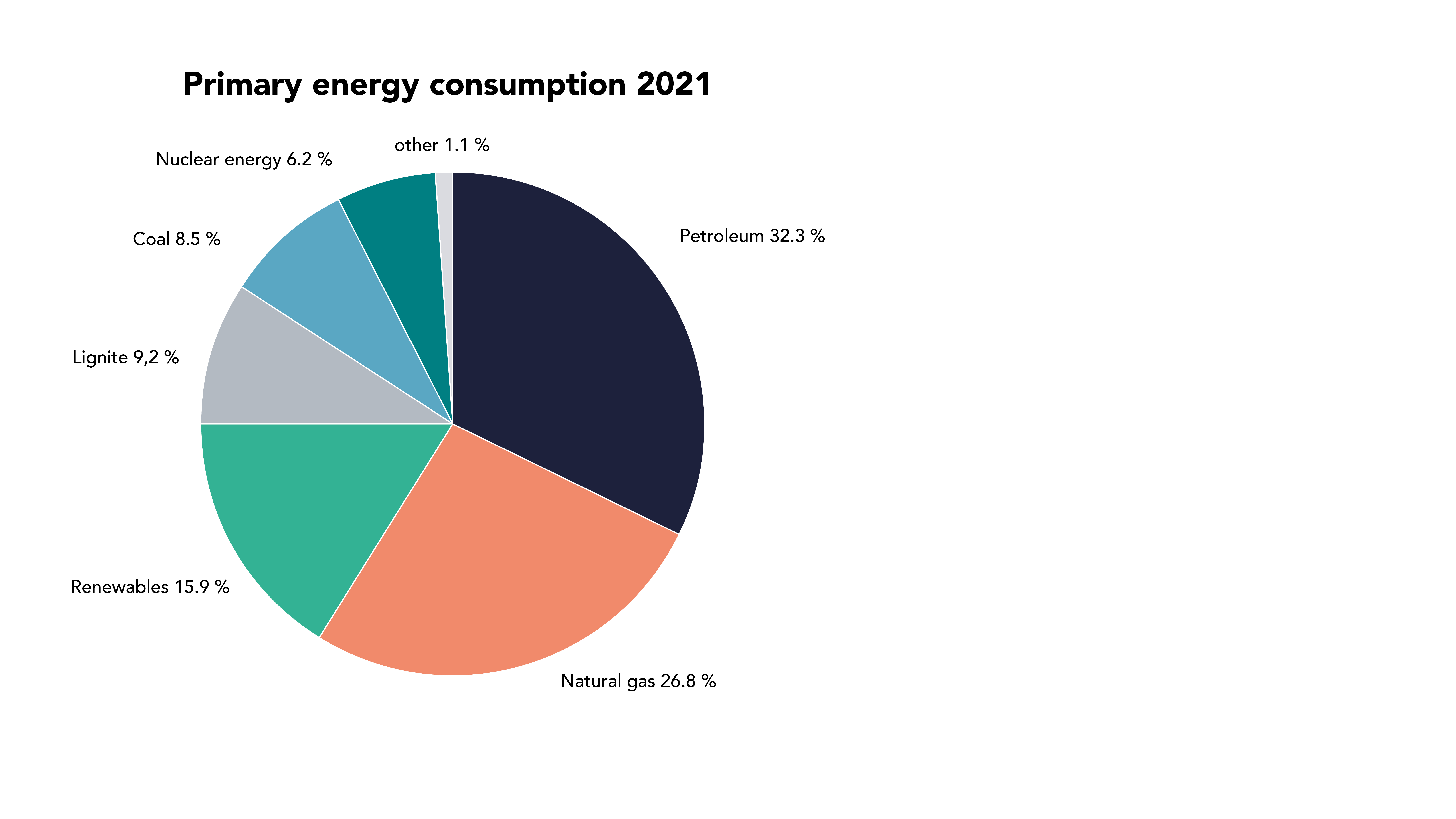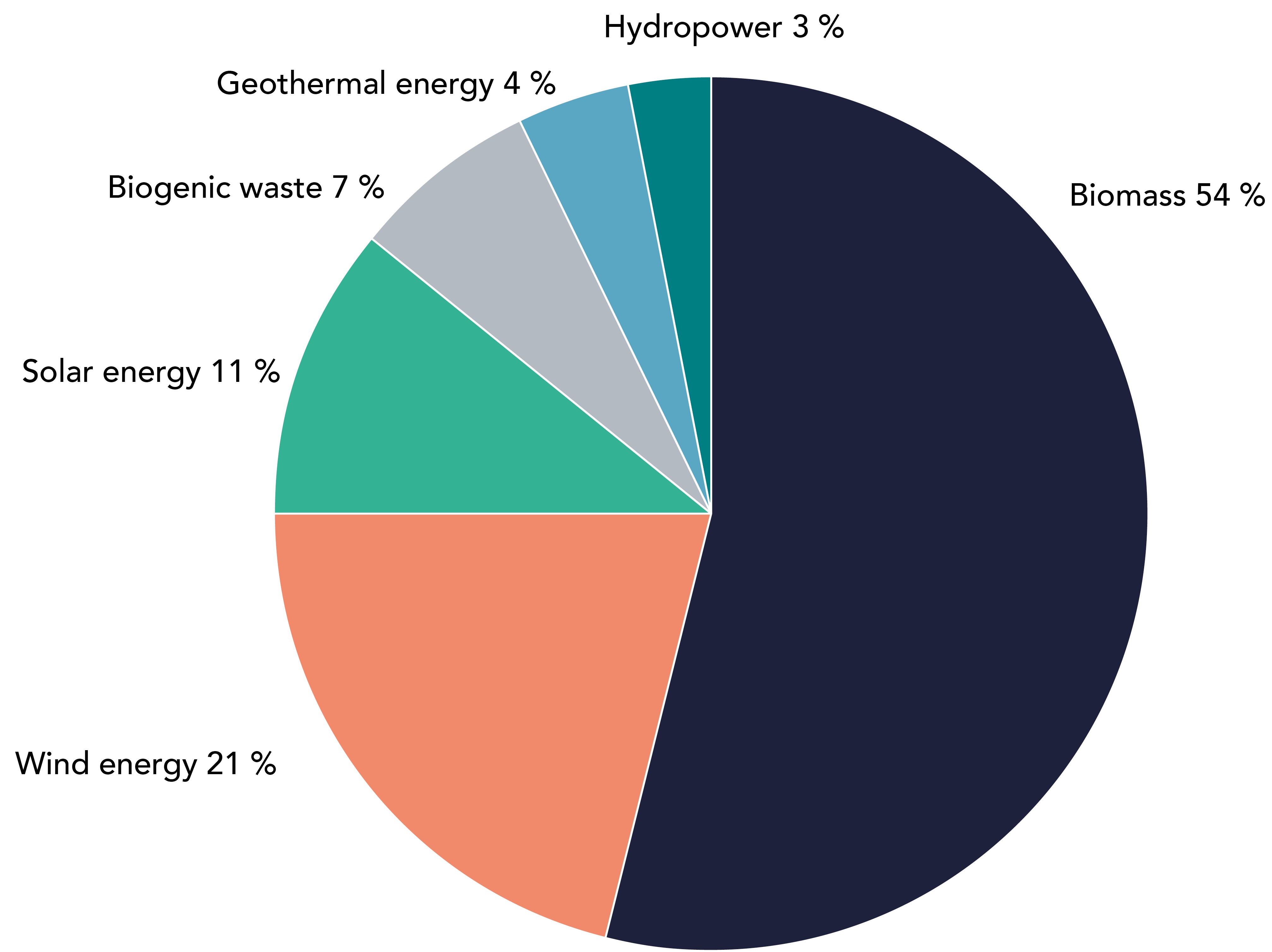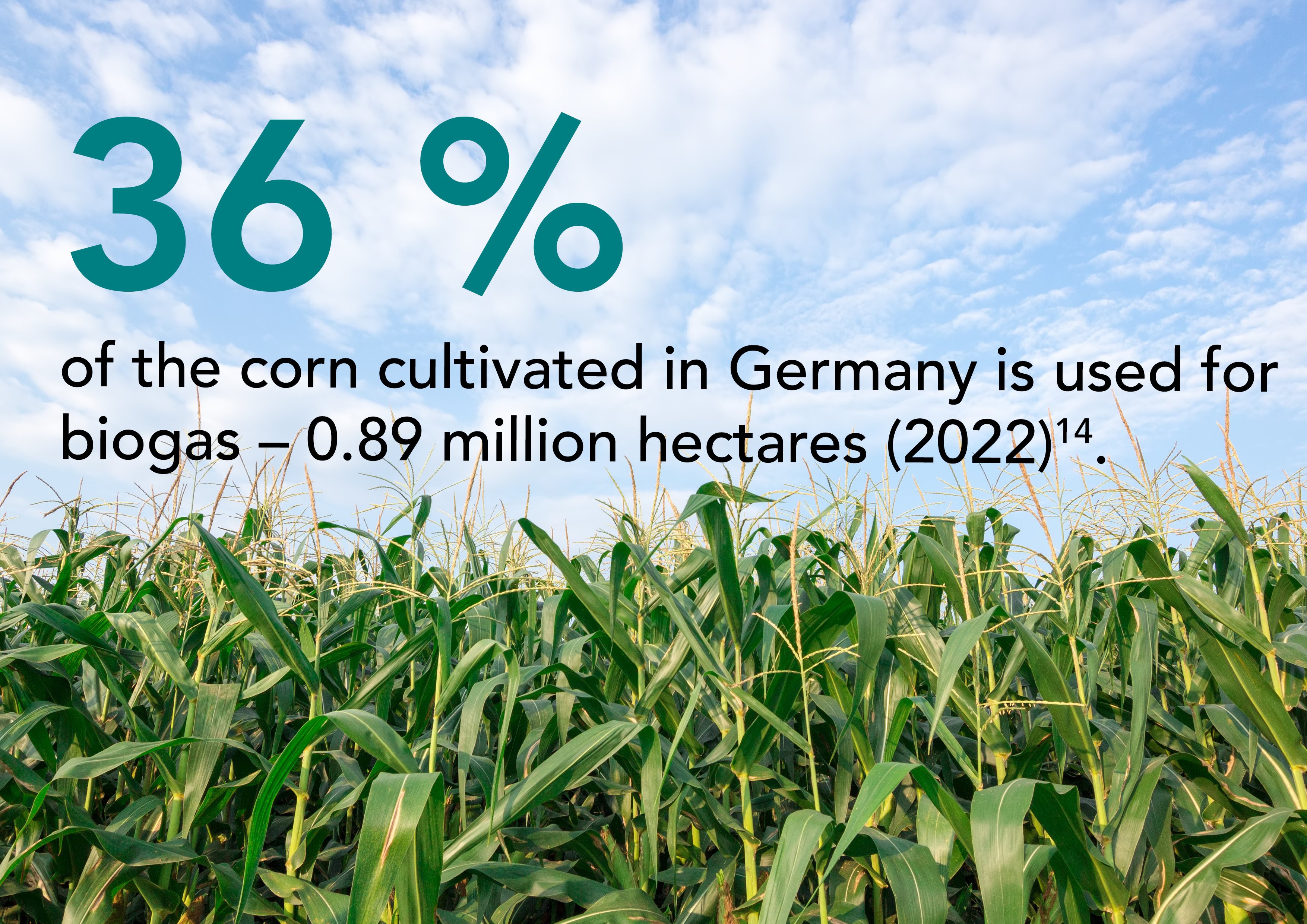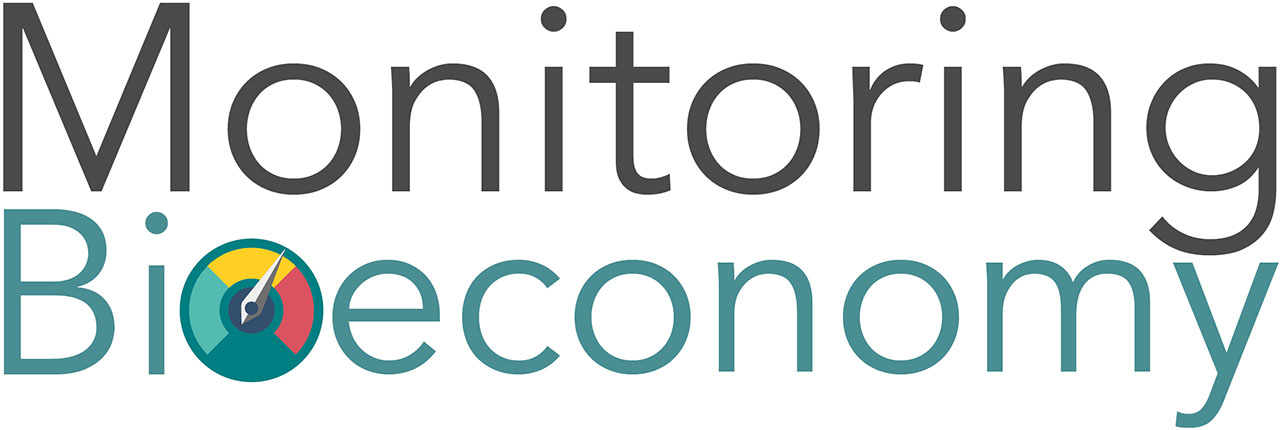Energy use I Should bioenergy be promoted more strongly? I Outlook
Energy use: Breakdown of energy source and consumption in Germany
Germany is heavily dependent on fossil fuels for its energy supply (more than three-quarters of primary energy stemmed from fossil sources in 2021) [1].

Primary energy consumption 2021 in Germany. (Source: FNR [17]).
To mitigate climate change, the amount of energy use needs to shrink (energy efficiency) and the share of renewable energies needs to further increase, replacing coal, oil and natural gas. With the Ukraine war, this has become even more urgent. To make Germany independent of Russian natural gas, the German government has passed comprehensive legislative changes in the "Easter Package" [2] to accelerate the expansion of renewables.
Bioenergy (biomass and biogenic “waste”) make up the majority of the "renewable" energies consumed in Germany. Biomass accounted for 54% of the "renewable" energy supply in 2021, with an additional 7% coming from biogenic “waste”. Thus, bioenergy comprises a larger share of the primary energy mix than wind (21% of all renewables in 2021) or solar (11% of all renewables in 2021) [3].

Primary energy consumption of renewables 2021 in Germany. (Source: FN [18]).
Most energetic use of biomass occurs in the heating sector. In 2021 an estimated 171 TWh stemmed from biomass, comprising by far the largest share of "renewables" for heat (86%, with e.g. modest shares of geothermal and solar thermal energies completing the picture) [4]. The breakdown looks different in the electricity sector, where an estimated 51 TWh stemmed from bioenergy (the majority from biogas and biogenic solid fuels [4] - e.g. in cogeneration plants). Around 40% of Germany’s gross electricity generation in 2021 came from renewables (with nearly half of those renewables from wind, 21.6% from bioenergy and 21.4% from photovoltaics) [4]. In the transport sector, biofuels comprised 5.7% (by energy) of Germany’s fuel consumption in 2021 [4].
Should bioenergy be promoted more strongly?
There is no simple answer to this question. Bioenergy is produced in diverse contexts with very different impacts on land use, resource demands and climate change. Each sector should thus be looked at individually, as well as a whole and in the context of overarching demands and limits.
Wood for heating: The main users of wood-based heating are private households. 46% of the wood used for energy in Germany was used in private households (2020) [5]. Wood is the primary heating source for 1.1 million households, and 11.2 million households in Germany use wood as an additional heating source[5]. Big combined heat and power plants (over 1 MW) burned over 22 Mm3 of wood-based materials in 2020 [6]. This corresponds to 37% of total energy wood, including primary and secondary sources. However, the burning of wood, especially at industrially scales, has raised environmental and health concerns [7] related to particle emissions, carbon emissions [8] and trade-offs with leaving e.g. trees to grow in the forest [9] (or as deadwood) to strengthen forests’ role as a carbon sink or contribute to ecosystem services. UBA has developed a handbook [10] to support the smart use of energy wood, especially in households.
In September 2022, MEPs voted for continuing the classification of wood combustion as sustainable energy, while at the same time capping the allowed amount at the level of the average consumption between 2017 and 2022 and limiting government subsidies [11]. Thereby, the legislation seeks to mitigate "competing uses" induced by an increasing use of energy wood and the additional growing demand for biomass in other sectors (such as construction). This is consistent with the key strategy to increase cascading use (material recycling before energetic recovery) as part of the circular bioeconomy. A recent study found that around 70% of waste wood in Germany was burned while around 15% was used for particleboard production [12].
Electricity and heat from biogas plants: Biogas contributed around 10 TWh of biomethane, or the equivalent of 1% of Germany’s natural gas consumption, in 2018 [13]. Biogas production is mainly based on corn silage (65%) [14]. The cultivation of corn requires agricultural land, which is thereby not available for food, feed or material production. In Germany, 0.89 million hectares (2022) were used to grow corn for biogas, which comprised 36% of total corn cultivation [14] and corresponds to an area more than three times as big as Saarland.

Similar as for biogas, biofuels in the transport sector are mainly based on raw materials that alternatively could have been used as food and feed, or whose land would be suitable for food or feed cultivation (so-called conventional biofuels) [15]. Land conversion and competition for land create a sustainability dilemma in this area: “Food vs. Fuel” has become a common expression to highlight land use conflicts in the public debate. Sometimes also put together with "feed”, reflecting also Germany’s large proportion of croplands used to feed its livestock (see food and feed). The Renewable Energy Directive II (RED II), adopted in 2021, limits the share of biomass used for conventional biofuels to 7% [16]. Research projects are exploring 2nd and 3rd generation fuels with mixed potentials and limitations. The scalability of these emerging fuels depends not only on the technological innovations and land requirements of the biomass itself, but also on how they fit into the overarching system of production and consumption (e.g. as jet fuel, public mobility, etc.).
Outlook
Bioenergy from secondary resources is a good way to both achieve environmental goals and increase energy security. Nevertheless, trade-offs with building up the circular bioeconomy require smart prioritization and a systemic understanding of biomass flows, potentials and limits. Further research projects and initiatives are working to develop applicable, sustainable and future-oriented pathways for energy security in the balanced bioeconomy. Energy efficiency and smart use are critical aspects of meeting all visions of a sustainable future.
Notes and references
- FNR nach AGEB, AGEE-Stat (2022). Available at: https://mediathek.fnr.de/grafiken/daten-und-fakten/bioenergie/primarenergieverbrauch-2021.html.
- The German Government (2022). We’re tripling the speed of the expansion of renewable energies. https://www.bundesregierung.de/breg-de/themen/klimaschutz/amendment-of-the-renewables-act-2060448.
- FNR nach AGEE-Stat/AGEB (2022). Available at: https://mediathek.fnr.de/grafiken/daten-und-fakten/bioenergie/primarenergieverbrauch-erneuerbarer-energietrager-2021.html.
- FNR (2022). Basisdaten Bioenergie Deutschland 2022. https://www.fnr.de/fileadmin/Projekte/2022/Mediathek/broschuere_basisdaten_bioenergie_2022_06_web.pdf.
- FNR (2022). Fakten zum Thema Holzenergie. Available at: https://heizen.fnr.de/heizen-mit-holz/fakten-zum-thema-holzenergie. Note: Energy wood supply consists of both derb wood from forests (16.2 Mm3) and waste wood (13.5 Mm3) plus others (like residues and landscaping).
- BMEL(2022). Wärme aus Holz. Available at: https://www.bmel.de/DE/themen/wald/holz/waerme-aus-holz.html.
- Mather-Gratton et al. (2021). Understanding the sustainability debate on forest biomass for energy in Europe: A discourse analysis. doi: 10.1371/journal.pone.0246873.
- The issue of carbon neutrality is contested. That is because it depends on the time lag in “offsetting” the carbon emissions, which is highly dependent on what, where and how wood is burned and sourced. For more information see (links follow and connection to 4.2.2)
- “Wood that remains in the forest in the form of living trees or deadwood can make at least as great and often even greater a contribution to climate protection than when it is used for energy and inefficient materials” in Luick et al. (2022). Primeval, natural and commercial forests in the context of biodiversity and climate protection – Part 2: The Narrative of the Climate Neutrality of Wood as a Resource. doi: 10.1399/NuL.2022.01.02.e.
- Behnke and UBA (2020). Heizen mit Holz: Ein Ratgeber zum richtigen und sauberen Heizen mit Holz. Available at: https://www.umweltbundesamt.de/sites/default/files/medien/1410/publikationen/2020_heizen_mit_holz_bf.pdf.
- https://www.europarl.europa.eu/news/en/press-room/20220909IPR40134/parliament-backs-boost-for-renewables-use-and-energy-savings. For a summary see also a article in the Süddeutsche Zeitung (2022). Kontroverse über EU-Beschluss zur Holzverbrennung. Available at: https://www.sueddeutsche.de/bayern/energie-muenchen-kontroverse-ueber-eu-beschluss-zur-holzverbrennung-dpa.urn-newsml-dpa-com-20090101-220915-99-770802.
- Döring and Mantau (2021). Altholz im Entsorgungsmarkt. Available at: http://infro.eu/index_en.php.
- Stemming from 213 biogas faciliities. See: Linke (2022). Biogas: regional, fair, klimaneutral. Available at: https://www.fnr.de/fileadmin/Projekte/2021/Mediathek/schriftenreihe_standdez.pdf.
- Statistisches Bundesamt, FNR (2023). Maisanbau in Deutschland. Available at: https://mediathek.fnr.de/grafiken/maisanbau-in-deutschland.html.
- Bringezu et al. (2020). Pilotbericht zum Monitoring der deutschen Bioökonomie. doi: 10.17170/kobra-202005131255.
- Joint Research Center, Renewable Energy – Recast to 2030 (RED II). Available at: https://joint-research-centre.ec.europa.eu/welcome-jec-website/reference-regulatory-framework/renewable-energy-recast-2030-red-ii_en.
- Available online at: https://mediathek.fnr.de/grafiken/daten-und-fakten/bioenergie/primarenergieverbrauch-2021.html.
- Available online at: https://mediathek.fnr.de/grafiken/daten-und-fakten/bioenergie/primarenergieverbrauch-erneuerbarer-energietrager-2021.html.



